I was introduced to New York ironweed (
Vernonia noveboracensis) in a demonstration meadow at the New England Wild Flower Society’s headquarters in Framingham, Massachusetts. At about 7 feet tall, it held its purple puffball flowers well above the other plants in that moist meadow. I thought, “What a gorgeous plant, but it would be way too big for my little residential garden.” Now that I am living in a rural area, I have much more room for this big pollinator magnet, and it provides lots of flowers and food for butterflies and bees during the second half of summer.
Not on the East Coast? Browse plants native to more regions of the U.S.
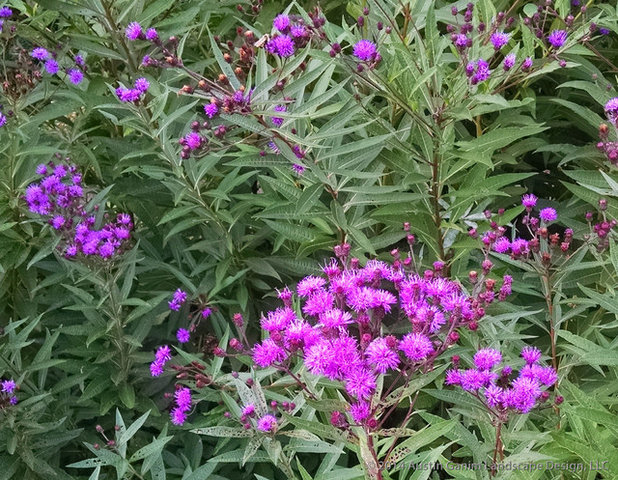
Austin Ganim Landscape Design, LLC
Botanical name: Vernonia noveboracensisCommon name: New York ironweed
Origin: Native from Massachusetts and Pennsylvania south to Georgia, with scattered populations to northern Florida
Where it will grow: Hardy to -20 degrees Fahrenheit (USDA zones 5 to 9; find your zone)
Typical plant communities: In nature it is found growing in low woods, moist meadows and along stream banks.
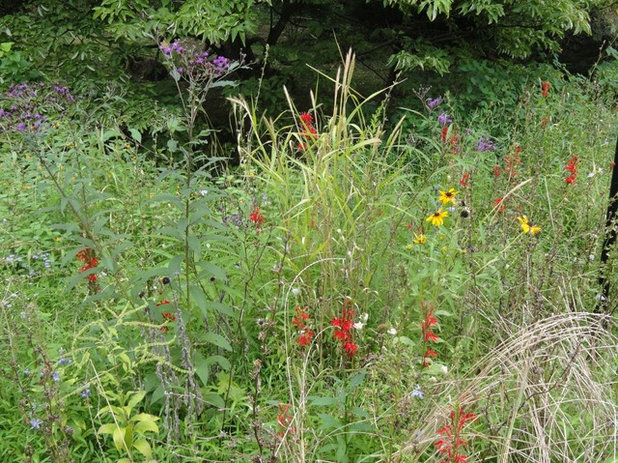
GreenWeaver Landscapes, LLC
Water requirement: Prefers medium to wet soil. In a garden setting, it can handle drier conditions and even brief periods of drought, but its growth will be somewhat stunted. Considering its large stature, this may not be so bad.
Light requirement: Partial to full sunshine
Mature size: Upright perennial that grows 4 to 8 feet tall and 2 to 5 feet across
Benefits and tolerances: Great pollinator plant for late summer; has very strong, upright stems that resist being pushed over and can support other weaker plants; tolerates wet conditions and clay soils; will grow well near black walnut trees (juglone-tolerant); will even grow in caliche; deer do not seem to bother it
Shown: New York ironweed in a mixed naturalistic planting with cardinal flower (
Lobelia cardinalis) and black-eyed Susan (
Rudbeckia sp.)
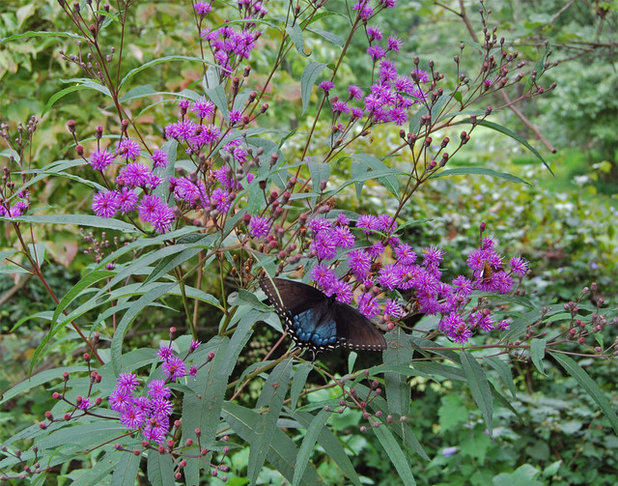 Seasonal interest:
Seasonal interest: The blooming period begins in late July and runs well into September in the mid-Atlantic region. As the first flush of flowers subsides, seed maturation begins with the formation of feathery white bristles on the seeds (the pappus). After the seeds disperse, the dried flowers resemble rust-colored puff balls. In December the still-erect stems bear star-like sepals that catch the winter sun.
When to plant: Container plants can be planted in spring or fall. I have had good results transplanting and dividing plants in the spring. The seeds mature in the fall and can be direct-seeded at that time, or they can be started indoors after two months of cold, moist stratification. The seedlings grow rapidly and may even reach blooming size the first year; plants and seeds may be available from nurseries featuring native species.
Shown: A spicebush swallowtail butterfly gathering nectar in mid-August as the ironweed approaches full bloom
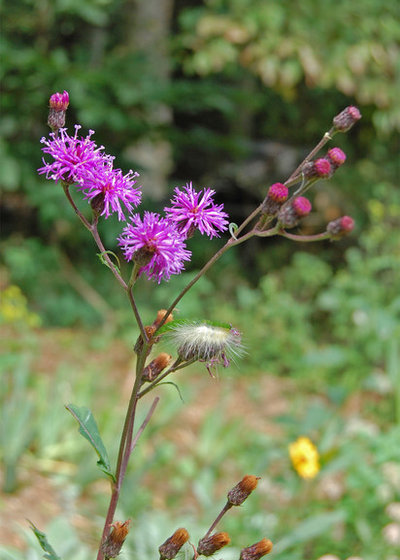 Distinguishing traits.
Distinguishing traits. New York ironweed is a tall, strong perennial that typically grows 4 to 8 feet tall without tipping over. Dense clusters of magenta to purple flowers top its stems from early August into September.
Its flowers are special for a member of the
Asteraceae family in that there are only disk flowers and none of the ray flowers (or petals) normally associated with asters. Each of these disk flowers has a ¼-inch-long tube, which gives the inflorescence a puff-ball appearance. The inflorescences are grouped into broad clusters, called cymes, resulting in large masses of flowers blanketing the top of the plant.
Its olive green leaves are long and narrow, with serrated edges. This gives the plant an overall coarse texture. At a distance it looks similar to Joe Pye Weed (
Eupatorium spp.), but ironweed’s leaves are arranged alternately on the stems, rather than opposite or in whorls.
I’ve read several explanations for the name
ironweed: One is its very strong stems that hold the plant erect well into winter. Another is the rust-colored dried flower heads that remain after the seed has been dispersed.
Shown: Flowers fully opened and with developing seed (with a white fluffy pappus)
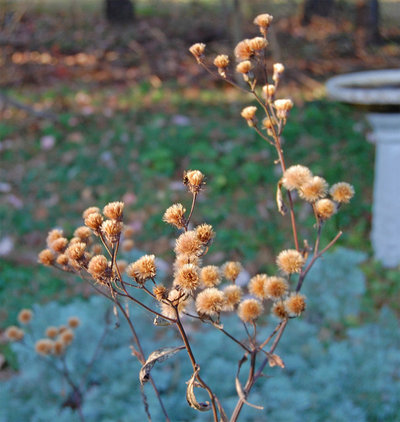
By early November all the seeds are gone, but the dried rust-colored petals of the disk flowers remain.
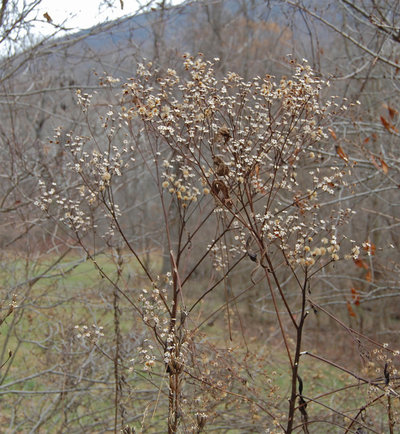
The strong stems are still upright in this photo taken in December. The remaining star-shaped sepals catch the low winter sunlight.
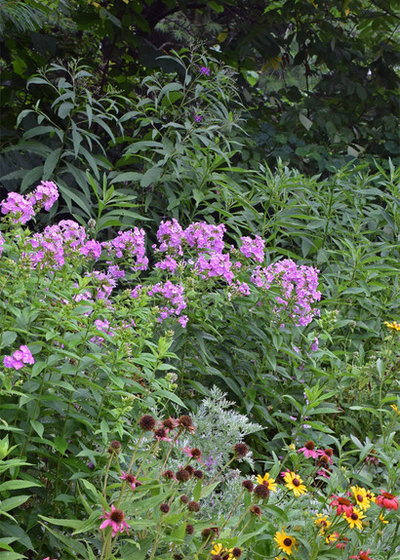 How to use it.
How to use it. New York ironweed’s large size makes it a good focal-point plant or an addition to the back of a bed; its strong stems can be used to support other weaker-stemmed perennials. Its root mass is very dense and strong, so it could be used to stabilize a slope. One of my plants is on a hill sloping away from a pool enclosure. The flowers are still easy to see, because the height of the plant compensates for its position on the slope. Under less-than-ideal conditions, and with a little late-spring pruning, ironweed won’t grow as large, bringing it into scale for a medium-size garden.
Some other native plants that you might find alongside New York ironweed are New England asters (
Symphyotrichum novae-angliae), Canada goldenrod (
Solidago altissima), cutleaf coneflower (
Rudbeckia laciniata), great blue lobelia (
Lobelia siphilitica), sneezeweed (
Helenium autumnale) and Joe Pye Weed.
In a garden setting it works well with other plants in cool red shades and contrasts nicely with yellow ones. You can combine it with many of the taller perennials, such as beebalm (
Monarda spp.), garden phlox (
Phlox paniculata and cvs.), purple coneflowers (
Echinacea purpurea and cvs.) and smooth oxeye (
Heliopsis helianthoides).
Shown: 6-foot tall ironweed blooming in late July. Other plants in bloom here are garden phlox, black-eyed Susan (
Rubeckia hirta) and a coneflower cultivar (
Echinacea ‘Cheyenne Spirit’).
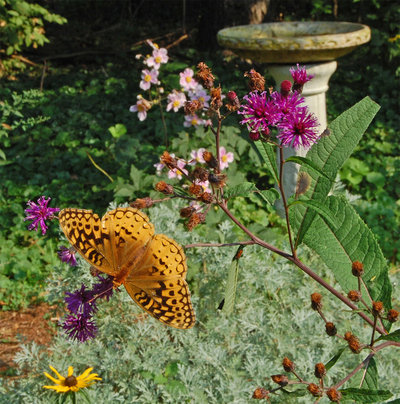 Planting notes.
Planting notes. New York ironweed is happiest in moist, loamy soil, but its powerful roots can cut through clay soil. Its large size can be tempered by siting it in a drier soil. It can also be shortened by cutting it back to 6 to 24 inches in early June, depending on how tall you want the plant to be.
New York ironweed attracts a wide variety of butterflies and long-tongued bees. In the fall the seeds are consumed by birds. It does produce a lot of seed. If you need to keep it under control, remove spent flower heads before the seeds mature in fall.
Mildew can be a problem, but you can reduce it by providing good air circulation.
Shown: A great spangled fritillary visiting an ironweed in early September. While many flowers have passed, some new buds are still opening.
More See more ways to attract birds and butterflies to your garden
Browse plants native to other regions of the U.S.





